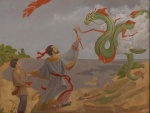Famous article on Shimpaku collecting in Japan
+3
JimLewis
Robert J. Baran
John Romano
7 posters
Page 1 of 1
 Famous article on Shimpaku collecting in Japan
Famous article on Shimpaku collecting in Japan
A few years back the US branch of the World Bonsai Friendship Federation published an English language translation of a fantastic article about the history of yamadori shimpaku collecting in Japan that had been originally published in Japanese in Kinbon magazine. Along with the illuminating text were accompanying photographs of famous collectors and trees. The article was called "Shimpaku Juniper: It's Secret History". This was the original link:
www.bonsai-wbff.org/shimpaku/main.shtm
This website no longer exists as the WBFF is now run by a Chinese organization (http://www.wbff-2013.org) and that article is no longer available.
Here is a link from the old Bonsai Talk site of the first page: http://www.bonsaitalk.com/lug/directory-link/n-910.html and the text can be found here (towards the bottom of the page):
http://www.absolutebonsai.com/shimpaku_juniper_bonsai
However, I would really like to get a copy of the original english article with photo's. Anyone have an archived copy of it? or anyone with wikileak like powers can find it somewhere on the web?
I might try to find someone from the North American WBFF board who might know if it still exists somewhere.
It was a great reference arrticle.
Not sure if this is the correct forum for this question but I know it is the most used.
thanks,
John Romano
www.bonsai-wbff.org/shimpaku/main.shtm
This website no longer exists as the WBFF is now run by a Chinese organization (http://www.wbff-2013.org) and that article is no longer available.
Here is a link from the old Bonsai Talk site of the first page: http://www.bonsaitalk.com/lug/directory-link/n-910.html and the text can be found here (towards the bottom of the page):
http://www.absolutebonsai.com/shimpaku_juniper_bonsai
However, I would really like to get a copy of the original english article with photo's. Anyone have an archived copy of it? or anyone with wikileak like powers can find it somewhere on the web?
I might try to find someone from the North American WBFF board who might know if it still exists somewhere.
It was a great reference arrticle.
Not sure if this is the correct forum for this question but I know it is the most used.
thanks,
John Romano
John Romano- Member
 Famous article on Shimpaku collecting in Japan
Famous article on Shimpaku collecting in Japan
John,
I was talking to Chris Cochrane the other night about this. Please see the bottom of http://www.phoenixbonsai.com/OtherArchived.html . I tracked down apparently intact links at the Internet Wayback Machine Archive and have them posted on that page. Let me know if there are any other old WBFF/NABF articles that it would be good to keep.
Robert J. Baran
I was talking to Chris Cochrane the other night about this. Please see the bottom of http://www.phoenixbonsai.com/OtherArchived.html . I tracked down apparently intact links at the Internet Wayback Machine Archive and have them posted on that page. Let me know if there are any other old WBFF/NABF articles that it would be good to keep.
Robert J. Baran

Robert J. Baran- Member
 Re: Famous article on Shimpaku collecting in Japan
Re: Famous article on Shimpaku collecting in Japan
Wow! Robert! I was hoping you would see this. You would be one to know this!
I was going to email you next if no one else could help.
You are THE bonsai historian.
Thanks for all your work on this.
I highly recommend this article for anyone who is interested in the history of bonsai in Japan and the world.
Merry Christmas and Happy New Year to you and yours!
Peace through bonsai,
John
I was going to email you next if no one else could help.
You are THE bonsai historian.
Thanks for all your work on this.
I highly recommend this article for anyone who is interested in the history of bonsai in Japan and the world.
Merry Christmas and Happy New Year to you and yours!
Peace through bonsai,
John
John Romano- Member
 Re: Famous article on Shimpaku collecting in Japan
Re: Famous article on Shimpaku collecting in Japan
Robert . . . once again, thanks for all the work you do -- and thanks also to Phoenix Bonsai for the space -- putting together the amazing resources that you have gathered. I doubt I'll live long enough to explore all of it.
I hope 2011 goes well for you!!!
I hope 2011 goes well for you!!!

JimLewis- Member
 Re: Famous article on Shimpaku collecting in Japan
Re: Famous article on Shimpaku collecting in Japan
Thankyou Robert for this very interesting article.
Guest- Guest
 Re: Famous article on Shimpaku collecting in Japan
Re: Famous article on Shimpaku collecting in Japan
I enjoyed reading the article and feel like I learned lots! Thank you.
Todd
Todd

Todd Ellis- Member
 Re: Famous article on Shimpaku collecting in Japan
Re: Famous article on Shimpaku collecting in Japan
Does anyone else see the sadness in the disappearance of the cliffside junipers mentioned in the article?
Should this be a wake up call for yamadori collectors?
Should this be a wake up call for yamadori collectors?

Rob Kempinski- Member
 Re: Famous article on Shimpaku collecting in Japan
Re: Famous article on Shimpaku collecting in Japan
Rob Kempinski wrote:Does anyone else see the sadness in the disappearance of the cliffside junipers mentioned in the article?
Should this be a wake up call for yamadori collectors?
Should be Rob, but there are too many out there for a quick buck unfortunately. Japanese included
Guest- Guest
 Re: Famous article on Shimpaku collecting in Japan
Re: Famous article on Shimpaku collecting in Japan
Rob,
I agree with you, but to speak out, all you're going to do is make a lot of enemies. Especially since, as someone put it ------ from seed / cutting [ airlayers as well ?], they have yet to match the quality of the yamadori.
I guess it is unknown that trees show mature characteristics after 10 to 15 years [ only in the tropics ?] of growing. Plus stable exposed hardwood normally occurs after 50 years of maturity, with those trees that have those properties.
My take on the above is --- simply create a calculated shape that when young and slim will with time and cambium growth thicken to an attractive mature tree. [ may need to be drawn.]
Khaimraj
I agree with you, but to speak out, all you're going to do is make a lot of enemies. Especially since, as someone put it ------ from seed / cutting [ airlayers as well ?], they have yet to match the quality of the yamadori.
I guess it is unknown that trees show mature characteristics after 10 to 15 years [ only in the tropics ?] of growing. Plus stable exposed hardwood normally occurs after 50 years of maturity, with those trees that have those properties.
My take on the above is --- simply create a calculated shape that when young and slim will with time and cambium growth thicken to an attractive mature tree. [ may need to be drawn.]
Khaimraj

Khaimraj Seepersad- Member
 Re: Famous article on Shimpaku collecting in Japan
Re: Famous article on Shimpaku collecting in Japan
Thanks so much for the links! 
Time to read!

Time to read!
hirow08- Member
 Re: Famous article on Shimpaku collecting in Japan
Re: Famous article on Shimpaku collecting in Japan
Khaimraj Seepersad wrote:Rob,
I agree with you, but to speak out, all you're going to do is make a lot of enemies. Especially since, as someone put it ------ from seed / cutting [ airlayers as well ?], they have yet to match the quality of the yamadori.
I guess it is unknown that trees show mature characteristics after 10 to 15 years [ only in the tropics ?] of growing. Plus stable exposed hardwood normally occurs after 50 years of maturity, with those trees that have those properties.
My take on the above is --- simply create a calculated shape that when young and slim will with time and cambium growth thicken to an attractive mature tree. [ may need to be drawn.]
Khaimraj
Kaimraj,
There is hope for non-yamadori. Most of the amazing bonsai junipers, Ficus and Celtis in Taiwan have been nursery/farm grown. Many of the pine trees in Japan are farm grown. All it takes is a market and patience.

Rob Kempinski- Member
 Re: Famous article on Shimpaku collecting in Japan
Re: Famous article on Shimpaku collecting in Japan
I'm with Rob here (if not on the climate change issue). I've cited this article (glad to find it again) often when arguing abut collecting -- especially commercial collecting. When I wrote an article for one of the North American Bonsai magazines a few years ago about the "Ethics of Collecting" I was surprised -- and honestly horrified -- at the hate mail I got in response.
Florida, has seen the depredations of commercial collectors on the wild orchid population, the bromiliads, the colorful tree snails (some of them extinct now!) corals on the reefs off the Keys; in Arizona, commercial cactus collectors have decimated populations of the unusual species; Hawaii has lost many bird populations (though more from from habitat loss and exotic animals and plants, than collecting).
If I were King of the World (or at least of all yamadori habitat) I'd flat-out ban collecting. Let people learn some true artistry with plants that Mother Nature hasn't sculpted before they got their predatory hands on them.
Florida, has seen the depredations of commercial collectors on the wild orchid population, the bromiliads, the colorful tree snails (some of them extinct now!) corals on the reefs off the Keys; in Arizona, commercial cactus collectors have decimated populations of the unusual species; Hawaii has lost many bird populations (though more from from habitat loss and exotic animals and plants, than collecting).
If I were King of the World (or at least of all yamadori habitat) I'd flat-out ban collecting. Let people learn some true artistry with plants that Mother Nature hasn't sculpted before they got their predatory hands on them.

JimLewis- Member
 Similar topics
Similar topics» Japan Times article today about Kunio Kobayashi
» Japan Times article today: Moss art: growing a masterpiece
» Oregon Shimpaku [Juniperus chinensis var. 'Shimpaku']
» Famous Juniperus literati
» INTERNATIONAL BONSAI ACADEMY with Walter Pall - The Plato's Cave Analogy
» Japan Times article today: Moss art: growing a masterpiece
» Oregon Shimpaku [Juniperus chinensis var. 'Shimpaku']
» Famous Juniperus literati
» INTERNATIONAL BONSAI ACADEMY with Walter Pall - The Plato's Cave Analogy
Page 1 of 1
Permissions in this forum:
You cannot reply to topics in this forum






